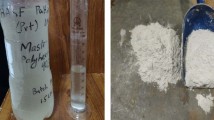Abstract
This study is concerned with needle-punched, nonwoven geotextile materials that have been used to develop full contact flexible moulds (FCFM) to treat soil specimens through microbial calcite precipitation (MICP) process by immersing method. MICP was induced through bacteria-urea reactions. The objective of this study was to figure out how different geotextiles influence the preparation of MICP-treated specimens. Five types of geotextiles were selected to prepare FCFM used for MICP treatment in this study. There is one singeing geotextile with the sintered side during these five geotextiles. Unconfined compression tests, four-point bending tests, and direct shear tests were conducted on MICP-treated specimens prepared by different geotextiles. The experimental results indicated that the mechanical properties of MICP-treated soil specimen prepared in FCFM made by G2 geotextile and G3 geotextile were similar. The unconfined compressive strength of the MICP-treated specimen reached 1.12 MPa (G2) and 0.90 MPa (G3), and MICP-treated specimens prepared by singeing geotextile had better performance than original geotextiles.













Similar content being viewed by others
References
DeJong JT, Fritzges MB, Nüsslein K (2006) Microbially induced cementation to control sand response to undrained shear. J Geotech Geoenviron Eng 132:1381–1392. https://doi.org/10.1061/(ASCE)1090-0241(2006)132:11(1381)
Whiffin VS, van Paassen LA, Harkes MP (2007) Microbial carbonate precipitation as a soil improvement technique. Geomicrobiol J 24:417–423. https://doi.org/10.1080/01490450701436505
DeJong JT, Mortensen BM, Martinez BC, Nelson DC (2010) Bio-mediated soil improvement. Ecol Eng 36:197–210. https://doi.org/10.1016/j.ecoleng.2008.12.029
Van Paassen LA, Daza CM, Staal M, Sorokin DY, van der Zon W, van Loosdrecht MC (2010) Potential soil reinforcement by biological denitrification. Ecol Eng 36:168–175. https://doi.org/10.1016/j.ecoleng.2009.03.026
Al Qabany A, Soga K, Santamarina C (2011) Factors affecting efficiency of microbially induced calcite precipitation. J Geotech Geoenviron Eng 138:992–1001. https://doi.org/10.1061/(ASCE)GT.1943-5606.0000666
Chou C-W, Seagren EA, Aydilek AH, Lai M (2011) Biocalcification of sand through ureolysis. J Geotech Geoenviron Eng 137:1179–1189. https://doi.org/10.1061/(ASCE)GT.1943-5606.0000532
Burbank M, Weaver T, Lewis R, Williams T, Williams B, Crawford R (2012) Geotechnical tests of sands following bioinduced calcite precipitation catalyzed by indigenous bacteria. J Geotech Geoenviron Eng 139:928–936. https://doi.org/10.1061/(ASCE)GT.1943-5606.0000781
Martinez B, DeJong J, Ginn T, Montoya B, Barkouki T, Hunt C, Tanyu B, Major D (2013) Experimental optimization of microbial-induced carbonate precipitation for soil improvement. J Geotech Geoenviron Eng 139:587–598. https://doi.org/10.1061/(ASCE)GT.1943-5606.0000787
Zhao Q, Li L, Li C, Li M, Amini F, Zhang H (2014) Factors affecting improvement of engineering properties of MICP-treated soil catalyzed by bacteria and urease. J Mater Civ Eng 26:04014094. https://doi.org/10.1061/(ASCE)MT.1943-5533.0001013
Li C, Yao D, Liu S, Zhou T, Bai S, Gao Y, Li L (2018) Improvement of geomechanical properties of bio-remediated Aeolian sand. Geomicrobiol J. https://doi.org/10.1080/01490451.2017.1338798
Bu C, Wen K, Liu S, Ogbonnaya U, Dong Q, Li L, Amini F (2018) Development of a rigid full-contact mould for preparing biobeams through microbial-induced calcite precipitation. Geotech Test J. 1:1. https://doi.org/10.1520/GTJ20170148
Wen K, Bu C, Liu S, Li Y, Li L (2018) Experimental investigation of flexure resistance performance of bio-beams reinforced with discrete randomly distributed fiber and bamboo. Constr Build Mater 176:241–249. https://doi.org/10.1016/j.conbuildmat.2018.05.032
Hammes F, Boon N, de Villiers J, Verstraete W, Siciliano SD (2003) Strain-specific ureolytic microbial calcium carbonate precipitation. Appl Environ Microbiol 69(8):4901–4909. https://doi.org/10.1128/AEM.69.8.4901-4909.2003
Liu S, Wen K, Armwood C, Bu C, Li C, Amini F, Li L (2019) Enhancement of MICP-treated sandy soils against environmental deterioration. J Mater Civ Eng 31(12):04019294. https://doi.org/10.1061/(ASCE)MT.1943-5533.0002959
Wani KS, Mir BA (2019) Effect of biological cementation on the mechanical behaviour of dredged soils with emphasis on micro-structural analysis. Int J Geosynth Ground Eng 5(4):32. https://doi.org/10.1007/s40891-019-0183-9
Zhao Q, Li L, Li C, Zhang H, Amini F (2014) A full contact flexible mould for preparing specimen based on microbial-induced calcite precipitation technology. Geotech Test J 37:917–921. https://doi.org/10.1520/GTJ20130090
Bu C, Wen K, Liu S et al (2018) Development of bio-cemented constructional materials through microbial induced calcite precipitation[J]. Mater Struct 51(1):30. https://doi.org/10.1617/s11527-018-1157-4
Ramachandran SK, Ramakrishnan V, Bang SS (2001) Remediation of concrete using microorganisms. ACI Mater J 98(1):3–9
ASTM D2166, D2166M-13 (2013) Standard test method for unconfined compressive strength of cohesive soil. ASTM International, West Conshohocken, PA. https://doi.org/10.1520/D2166_D2166M-13
ASTM D6272–17 (2017) Standard test method for flexural properties of unreinforced and reinforced plastics and electrical insulating materials by four-point bending. ASTM International, West Conshohocken, PA. https://doi.org/10.1520/D6272-17
ASTM D 3080, D3080-11 (2011) Standard test method for direct shear test of soils under consolidation drained conditions. ASTM International, West Conshohocken, PA. https://doi.org/10.1520/D3080_D3080M-11
Rebata-Landa V (2007) Microbial activity in sediments: effects on soil behavior. Georgia Institute of Technology. https://hdl.handle.net/1853/19720
Dassanayake DT, Oumeraci HOCINE (2012) Engineering properties of geotextile sand containers and their effect on hydraulic stability and damage development of low-crested/submerged structures. Int J Ocean Clim Syst 3(3):135–150. https://doi.org/10.1260/1759-3131.3.3.135
Fatt I (1956) The network model of porous media
Komori T, Makishima K (1979) Geometrical expressions of spaces in anisotropic fiber assemblies. Text Res J 49:550–555. https://doi.org/10.1177/004051757904900912
Muthukumaran AE, Ilamparuthi K (2006) Laboratory studies on geotextile filters as used in geotextile tube dewatering. Geotext Geomembr 24(4):210–219. https://doi.org/10.1016/j.geotexmem.2006.03.002
ISO 10318-1:2015 Geosynthetics: Part 1: terms and definitions. International Organization for Standardization, Geneva
e Silva RA, Negri RG, de Mattos Vidal D (2019) A new image-based technique for measuring pore size distribution of nonwoven geotextiles. Geosynth Int. https://doi.org/10.1680/jgein.19.00005
Acknowledgements
This paper is based upon work supported by the National Science Foundation Grant Nos. 1900151, 1924241 and GSI Fellowship grant for the academic year 2019–2020.
Funding
National Science Foundation Grant Nos. 1900151, 1924241 and GSI Fellowship grant for the academic year 2019–2020.
Author information
Authors and Affiliations
Corresponding author
Ethics declarations
Conflict of interest
On behalf of all authors, the corresponding author states that there is no confict of interest.
Additional information
Publisher's Note
Springer Nature remains neutral with regard to jurisdictional claims in published maps and institutional affiliations.
Rights and permissions
About this article
Cite this article
Liu, S., Wen, K., Amini, F. et al. Investigation of Nonwoven Geotextiles for Full Contact Flexible Mould Used in Preparation of MICP-treated Geomaterial. Int. J. of Geosynth. and Ground Eng. 6, 14 (2020). https://doi.org/10.1007/s40891-020-00197-z
Received:
Accepted:
Published:
DOI: https://doi.org/10.1007/s40891-020-00197-z




